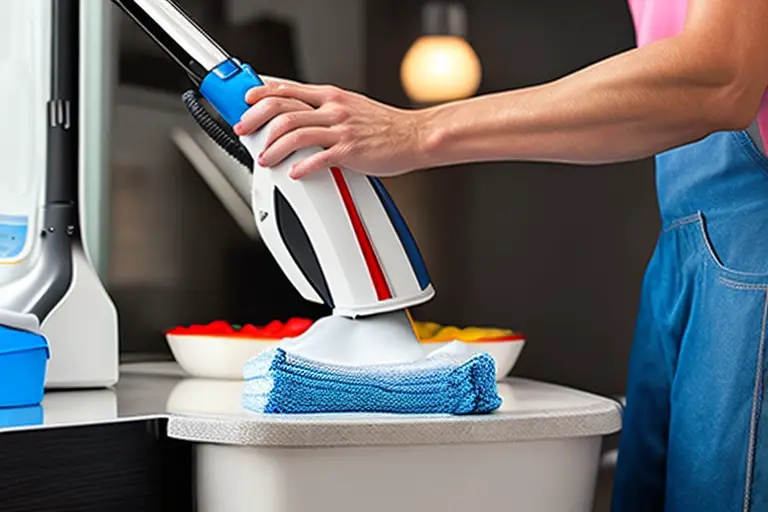In a world where cleanliness and hygiene have become increasingly important, steam cleaning has emerged as an effective, eco-friendly, and versatile method to keep our living spaces in top-notch condition. Steam cleaning not only helps remove dirt, grime, and stains from various surfaces, but also disinfects and sanitizes them, eliminating harmful bacteria, viruses, and allergens. In this comprehensive guide, we will delve into the world of steam cleaning, discussing its benefits, providing tips for choosing the right steam cleaner, and outlining the steps for effective disinfection. We will also explore steam cleaning techniques for different surfaces, offer safety precautions, and share valuable tips for maintaining your steam cleaner. By the end of this guide, you’ll have all the information you need to harness the power of steam cleaning for a cleaner, healthier living environment.
Understanding Steam Cleaning
Steam cleaning, also known as hot water extraction, is a cleaning method that uses the power of hot water vapor to break down dirt, stains, and other contaminants from various surfaces. The high temperature of the steam not only loosens and lifts grime but also kills bacteria, viruses, mold, and dust mites, making it an excellent choice for maintaining a hygienic living environment. Steam cleaning is suitable for a wide range of surfaces, including carpets, upholstery, tile, grout, and kitchen appliances.

Benefits of Using a Steam Cleaner
There are numerous advantages to using a steam cleaner for your cleaning tasks, including:
- Eco-Friendliness: Steam cleaning does not require harsh chemicals, making it an environmentally responsible choice.
- Deep Cleaning: The high pressure and temperature of the steam penetrate deep into the surface, effectively lifting dirt and grime.
- Disinfection: Steam cleaning kills bacteria, viruses, and other microorganisms, helping to create a healthier living space.
- Allergen Reduction: By eliminating allergens such as dust mites and pet dander, steam cleaning can help alleviate allergy symptoms and improve indoor air quality.
- Versatility: Steam cleaners can be used on a wide variety of surfaces, making them a valuable addition to your cleaning arsenal.
Choosing the Right Steam Cleaner
Selecting the right steam cleaner depends on your specific needs and cleaning requirements. Here are some factors to consider when making your choice:
- Size and Portability: Consider the size, weight, and portability of the steam cleaner, especially if you need to move it between rooms or floors.
- Tank Capacity: A larger water tank means fewer refills, but also increased weight and size. Choose a steam cleaner with a tank capacity that suits your needs.
- Heating Time: Look for a steam cleaner with a quick heating time for faster, more efficient cleaning.
- Steam Pressure and Temperature: Higher pressure and temperature levels result in more effective cleaning and disinfection. However, they may also pose a higher risk of damage to sensitive surfaces.
- Attachments and Accessories: Ensure the steam cleaner comes with a variety of attachments and accessories to tackle different surfaces and cleaning tasks.
Preparing for Steam Cleaning
Before you begin steam cleaning, it’s essential to prepare your space and the surfaces you plan to clean. Here are some tips:
- Clear the Area: Remove clutter, furniture, and other items from the area you plan to clean.
- Pre-treat Stains: Apply a stain remover to any visible stains on the surface, allowing it to work for a few minutes before steam cleaning.
- Vacuum or Sweep: Vacuum or sweep the surface to remove loose dirt, dust, and debris. This will help the steam cleaner to be more effective in lifting grime and contaminants.
Step-by-Step Guide to Disinfecting with a Steam Cleaner
Surface Preparation
As mentioned earlier, start by clearing the area, pre-treating stains, and vacuuming or sweeping the surface.
Filling the Steam Cleaner
Fill the water tank of the steam cleaner with clean water, following the manufacturer’s instructions. If your steam cleaner requires a cleaning solution, be sure to use one recommended by the manufacturer.
Operating the Steam Cleaner
Turn on the steam cleaner and allow it to heat up, as per the manufacturer’s guidelines. Once it’s ready, attach the appropriate nozzle or accessory for the surface you plan to clean.
Steam Cleaning Techniques for Different Surfaces
- Carpets: Move the steam cleaner slowly and evenly across the carpet, being careful not to oversaturate the fibers. Make overlapping passes to ensure thorough cleaning.
- Upholstery: Use a lower steam pressure setting and a gentle, back-and-forth motion to clean upholstery surfaces. Avoid oversaturating the fabric.
- Tile and Grout: Use a small, stiff brush attachment to clean grout lines, and a larger brush or cloth attachment for tiles.
- Kitchen Appliances:Use a detail nozzle or brush attachment to clean hard-to-reach areas in appliances such as ovens, microwaves, and refrigerators. Be cautious when cleaning around electrical components.
Safety Precautions
- Read the Manual: Always read and follow the manufacturer’s instructions for your specific steam cleaner model.
- Use Protective Gear: Wear gloves, eye protection, and long sleeves to protect yourself from hot steam and any debris that may be dislodged during cleaning.
- Avoid Overheating: Do not leave the steam cleaner running unattended, and turn it off when not in use to prevent overheating.
- Test on a Small Area: Before using the steam cleaner on a new surface, test it on a small, inconspicuous area to ensure it does not cause damage.
Tips for Effective Steam Cleaning
To get the most out of your steam cleaning efforts, follow these helpful tips:
- Work Methodically: Clean one area or room at a time, moving from top to bottom and left to right to avoid re-contaminating cleaned surfaces.
- Allow Surfaces to Dry: After steam cleaning, allow surfaces to dry completely before replacing furniture or walking on them. This helps prevent the growth of mold and mildew.
- Use Distilled Water: Using distilled water in your steam cleaner can help prevent mineral buildup and prolong the life of your machine.
- Change Cleaning Pads Regularly: Replace cleaning pads or cloths as needed to maintain optimal cleaning performance.
Maintenance and Care of Your Steam Cleaner
To ensure your steam cleaner remains in good working order, follow these maintenance and care tips:
- Empty the Water Tank: After each use, empty the water tank and allow it to air dry to prevent mold and mildew growth.
- Clean Attachments: Wash or replace attachments and accessories as needed, following the manufacturer’s guidelines.
- Inspect and Replace Filters: Regularly check and replace filters if your steam cleaner is equipped with them. This helps maintain optimal performance and prolongs the life of your machine.
- Store Properly: Store your steam cleaner in a cool, dry place, away from direct sunlight and extreme temperatures.
Summary
Steam cleaning is a powerful, eco-friendly, and versatile method for maintaining a clean and healthy living environment. By understanding the benefits of steam cleaning, choosing the right steam cleaner for your needs, and following proper techniques and safety precautions, you can harness the power of steam cleaning to effectively disinfect and sanitize various surfaces in your home. With regular maintenance and care, your steam cleaner will remain a reliable tool in your cleaning arsenal for years to come.

